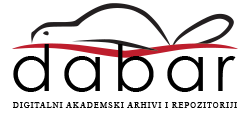| Abstract | Motori s unutarnjim izgaranjem su izuzetno zastupljeni kao pogonski agregati različitih
agregata, radnih strojeva, traktora, teretnih vozila, osobnih automobila, motocikla i sl.
Upravljane izmjenom radnog medija je posebno zahtjevna zadaća koju treba obaviti za
pouzdan, kvalitetan i efikasan rad svakog motora s unutarnjim izgaranjem. Upravo je
razvodni mehanizam motora zadužen za obavljanje ove zadaće.
U ovom radu su ukratko opisane različite izvedbe razvodnog mehanizma motora s unutarnjim
izgaranjem, način njihovih pogona, te materijale iz kojih se izvode pogonski članovi
razvodnog mehanizma.
Detaljnije su obrađeni razvodni mehanizmi pogonjeni lancem, s fokusom upravo na lanac kao
vrlo važan faktor pouzdanosti rada cijelog mehanizma.
U teorijskom dijelu su prikazane osnove za proračun i odabir lanaca, materijali iz kojih se oni
proizvode te standardi bitni za ispitivanje konstrukcije lanaca.
U praktičnom (eksperimentalnom) dijelu je provedena detaljna laboratorijska analiza
materijala oštećenog lanca. Također je obavljena usporedba geometrijskih značajki jednog
novog lanca (lanac za pogon motora oznake: N47D20, proizvođač BMW) sa oštećenim
lancem korištenim u automobilu koji je prešao put od 230 000 km. Utvrdilo se da trošenjem
lanca dolazi do promjene njegovih geometrijskih značajki (produljenje lanca, povećanje
zazora u njegovim člancima) što posredno ima utjecaj na ispravan i kvalitetan rad motora.
Promjenu geometrijskih karakteristika (do određene granice) kompenzira sustav za natezanje
lanca, pa je njegova ispravnost izuzetno važna siguran i kvalitetan rad motora. |
| Abstract (english) | Internal combustion engines are extremely common as power units of various aggregates,
working machines, tractors, trucks, passenger cars, motorcycles, etc.
Controlling the change of the working medium is a particularly demanding task that needs to
be performed for the reliable, high-quality and efficient operation of every internal
combustion engine. It is the engine timing mechanism that is responsible for performing this
task.
This paper briefly describes various designs of the timing mechanism of internal combustion
engines, the method of their drives, and the materials from which the driving members of the
timing mechanism are made.
Chain-driven timing mechanisms are discussed in more detail, with a focus on the chain as a
very important factor in the reliability of the entire mechanism.
The theoretical part presents the basics for calculating and selecting chains, the materials from
which they are made, and the standards important for testing the design of chains.
In the practical (experimental) part, a laboratory analysis of the material of the damaged chain
is performed. A comparison of the geometric characteristics of a new chain (mortar drive
chain, model: N47D20, manufacturer BMW) with a damaged chain used in a car that had
traveled 230,000 km was also performed. It was clearly established that chain wear leads to a
change in its geometric characteristics (lengthening of the chain, increasing the clearance in
its links), which of course has an impact on the correct and high-quality operation of the
engine.
The change in geometric characteristics (up to a certain limit) is compensated for by the chain
tensioning system, so its correctness is extremely important for safe and high-quality engine
operation. |

